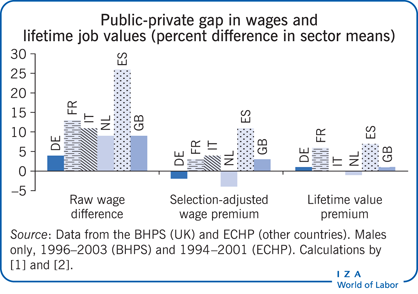Elevator pitch
Direct wage comparisons show that public-sector employees earn around 15% more than private-sector employees. But should these differences be interpreted as a “public-sector premium”? Two points need to be considered. First, the public and private sectors differ in the jobs they offer and the type of workers they employ, which explains a large share of the wage gap. Second, public- and private-sector careers also differ in other important dimensions, such as job stability and income progression, which are relevant to individual career choices. So any comparison of the two sectors should take these points into account.

Key findings
Pros
Public- and private-sector careers differ in many dimensions other than wages (e.g. job security, return to experience, etc.)
Differences in wages and other aspects of a career can be aggregated into a lifetime career value.
Wage differences between sectors are largely smoothed out over the life cycle: the average public-private gap in lifetime career values is close to zero in several major European countries.
The public and private sectors employ workers with different observable characteristics, and those differences explain a large share of the private-public wage gap.
Cons
Direct wage comparisons show that public-sector employees earn, on average, around 15% more than private-sector employees.
The vast literature on the public-private wage gap focuses on point-in-time differences in wages.
France and Spain stand out as two countries where low-skilled workers enjoy a sizeable lifetime public-sector premium.
Even after accounting for differences in composition, systematic cross-sector wage differences persist, often in favor of public-sector workers.